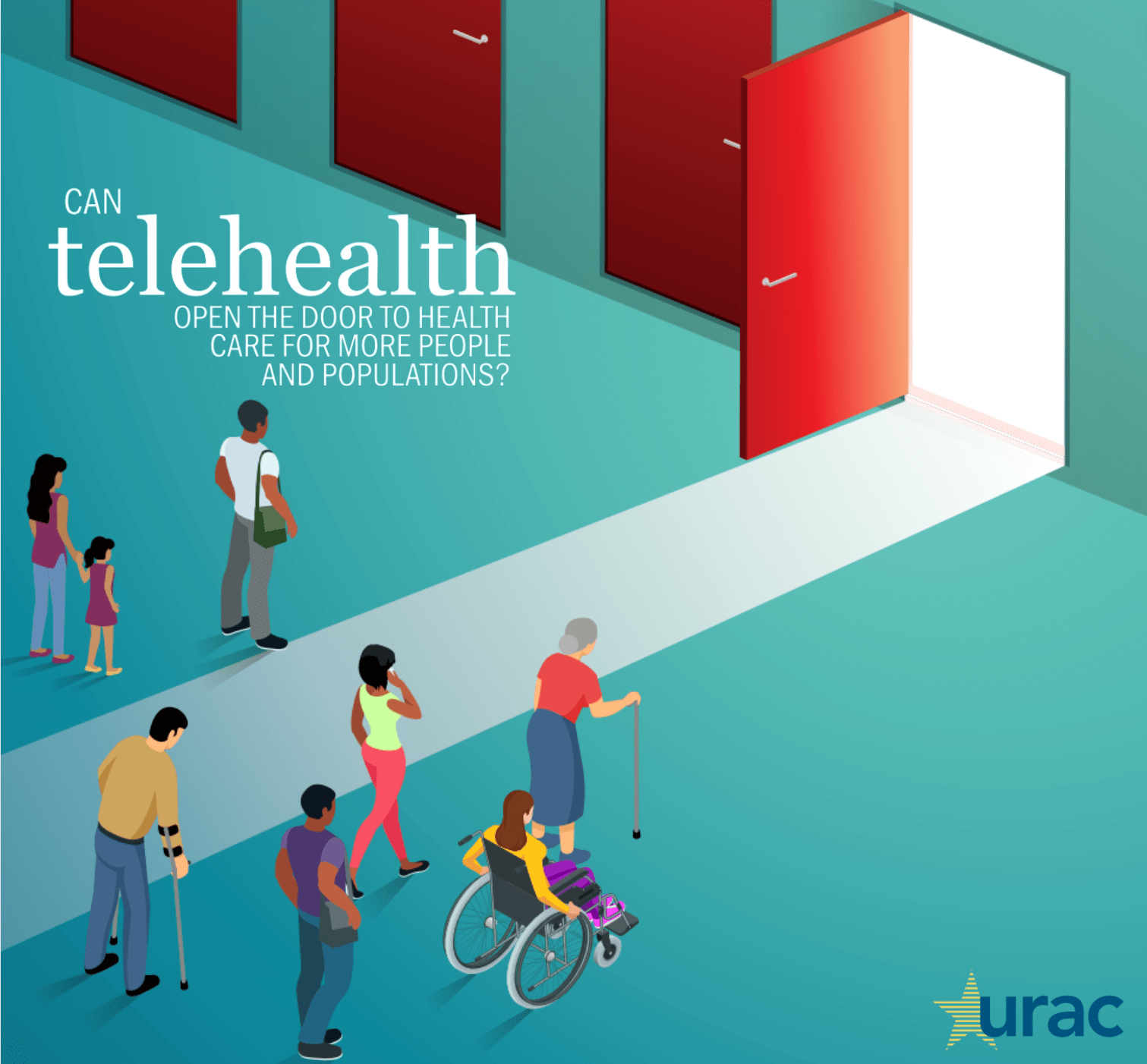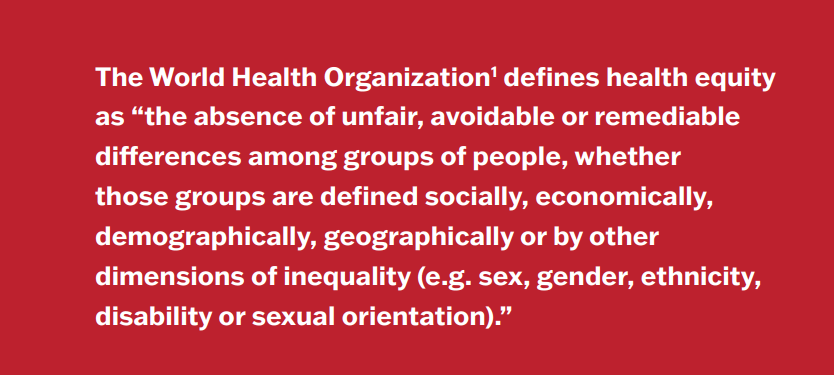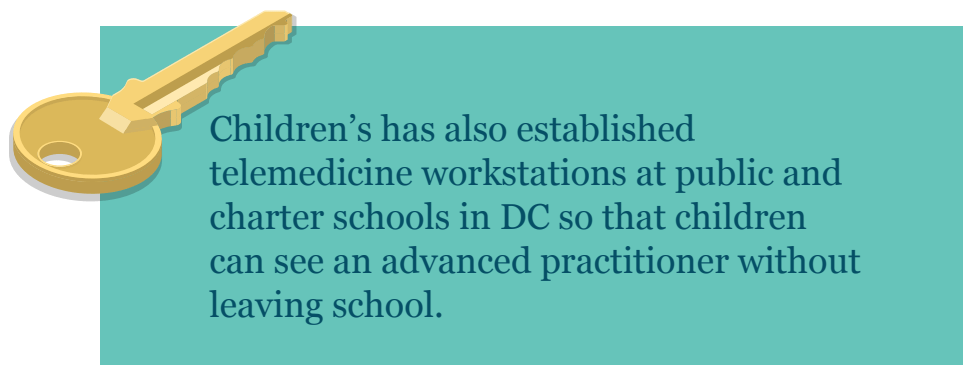
The door to quality health care is effectively shut for so many in the United States. Standing in the way are issues of affordability, availability, geography, transportation, bias and structural racism and discrimination.
How Can Telehealth Help?
As health systems and health care providers across the United States wrestle with how to achieve health equity in their patient populations and communities, one thing becomes abundantly clear: This multi-dimensional goal requires a multifaceted approach.
Telehealth helps solve some of health care’s equity challenges—and can create others. Providers who take advantage of its potential while addressing its potential challenges help create an overall health care system that serves more people in more situations.
“With telehealth, we can significantly lower the barrier to deliver care to a population,” says Shawn Griffin, MD President and CEO of URAC, an accrediting body that offers certifications in both telehealth and health equity. We all know access to health care is not distributed equally across all populations in the U.S., but we now have technology that reaches into places that health care hadn’t reached before.”
Instead of one door to a health care provider, telehealth effectively creates thousands of doors. But creating more doors is just one part of creating a more equitable, accessible health care system.
Providers must also make sure that those doors are equitably distributed, available, welcoming and free of new, unintended or unanticipated barriers.
The Center for Telehealth and e-Health Law (CTeL) is a nonprofit research institute that focuses on the legal and regulatory aspects of digital health with the goal of increasing health equity. “Our North Star at CTeL is being able to improve access to care to all patient populations,” says Executive Director Christa Natoli.

Dealing With the Digital Divide
A major issue standing in the way of telehealth’s potential to increase health equity and access to care is the digital divide. According to a 2024 report from the Pew Research Center2, 8+ in 10 homes have high-speed internet and 90 percent of U.S. adults have a smartphone. But that still leaves a significant portion of the population without the broadband access necessary to receive quality health care via telehealth. Those without internet access are most likely to be people of color and older people with lower incomes and less than a high school education—the same populations are also more likely to experience health disparities. Although people in rural areas are least likely to have internet access, the percentages are not that much higher in urban or suburban areas.
Plus, as Natoli points out, up to one third of mobile have pre-paid plans that put caps on data. “Sixty percent of those users are women, who are the primary drivers of health care for themselves and their families.”
One video visit can easily wipe out a user’s monthly data allotment. Free Wi-Fi in public places will not solve the problem for a medical or mental health appointment that requires privacy. Many coffee shops and other businesses that offer “free” Wi-Fi require users to buy something—which puts it out of reach for many.
Natoli also points out that people who have prepaid plans are on Medicaid or are otherwise un- or underinsured. They also are less likely to have a primary care provider. As a result, they often rely on emergency rooms for health care—which is not good for health outcomes and puts an often unnecessary burden on local health systems. Access to broadband internet in turn increases access to health care via telehealth—and benefits both patients and the health care system, Natoli believes.
CTeL is currently working with the University of Mississippi Medical Center and Old Dominion University to conduct research to see how providing patients with smartphones and unlimited data can impact emergency room use. Preliminary results show that emergency visits go down and communication with patients improves, leading to better outcomes for patients and less pressure on the health care system.
This is the idea behind the Affordable Connectivity Program (ACP)6, sponsored by the Federal Communications Commission that gives cellphones to low-income individuals. Since the program’s start at the end of 2021, more than 23 million households have enrolled. Before the program, more than two-thirds of these households had inconsistent or no internet connectivity. Nearly three-quarters of ACP households use internet service to schedule or attend health care appointments. Unfortunately, this program started winding down in April 2024 when Congress failed to reauthorize it.
Addressing policies and regulations around telehealth and access to technology can get us about 75 percent of the way to full access to telehealth, Natoli says, but that still leaves a lot of people who need access to care. Providers who want to serve their patient populations and communities use innovation, ingenuity and human touch to ensure telehealth moves us closer—not further—from health equity.
![“I don’t think anyone has cracked the code on making it [a] completely equitable process,” says Raichura, “but as we hear more feedback from our families, we’re continuing to evolve. We’re all committed to doing the work. We have to be able to solve for these disparities.” “I don’t think anyone has cracked the code on making it [a] completely equitable process,” says Raichura, “but as we hear more feedback from our families, we’re continuing to evolve. We’re all committed to doing the work. We have to be able to solve for these disparities.”](https://www.urac.org/wp-content/uploads/2024/07/08-07-2024-03-43-18.png)
Bringing Care to Kids and Their Families
As Director of Telemedicine at Children’s National, Tejal Raichura, MHA, focuses on connecting young patients and their families to providers and care teams virtually. She uses the term “techquity” to capture the close connection between health equity and access to technology, especially the internet.
“I don’t think anyone has cracked the code on making it [a] completely equitable process,” says Raichura, “but as we hear more feedback from our families, we’re continuing to evolve. We’re all committed to doing the work. We have to be able to solve for these disparities.”
According to Raichura, one of the biggest concerns in pediatric care is the complexity of the consenting process. A hitch in this process can stop a visit before it even happens, resulting in missed appointments and interruptions in care. With adult patients, consent is complex enough, but usually only one person needs to sign the forms. Pediatric patients may have more than one parent or guardian who may or may not live in the same location as each other or as the child, Raichura explains. Consent can also vary by service or the age of the patient.
At Children’s they start the process by sending links to parents or guardians to log onto the patient portal and sign the consent before the visit. This is integrated into the electronic medical record so the provider can easily check for it before the visit.
But sometimes parents don’t get the link, or don’t have time to click through and review the documents. Or maybe they don’t have internet access to log on to the portal or a different person is accompanying the child to the visit this time. In these cases, Children’s has a verbal consent process so the appointment can take place.
“Even if it’s just 10 percent of patients or 5 percent of patients who can’t follow the steps,” Raichura says, “we keep parallel pathways in place.”
Another challenge to accessing care is translation for families for whom English is not their primary language. At Children’s National, translation is built seamlessly into the flow of the telehealth visit by clicking a link on the platform that creates a HIPAA-compliant, secure three-way video call with the appropriate language interpreter. “We prefer [interpreters] join not just via audio, but video as well, so that they can pick up on nonverbal cues.” This is critically important for families that use American Sign Language, Raichura adds.
Getting a child to an in-person visit can mean taking the day off from school and work, which interrupts learning for the child and can lead to lost income for the parent. Telehealth offers a way to access follow-up or specialty consultations that allows children and their parents to stay closer to home, missing less work and school.
Children’s National serves families not only in Washington DC but also Virginia and Maryland (known as the DMV). Children’s has installed telemedicine carts at satellite clinics around the DMV equipped with USB stethoscope, otoscope and other instruments for collecting vital signs or examining patients. These offer “a middle ground” for patients who don’t have access to internet at home or don’t have a smart phone or a safe, quiet place for a telemedicine visit with their Children’s specialist. “Now we can hear heart sounds, lung sounds, we can use the otoscope and real time relay that information to get vitals—everything you would expect from going to the DC facility but keeping it as close to home as possible,” Raichura says.
Children’s has also established telemedicine workstations at public and charter schools in DC so that children can see an advanced practitioner without leaving school. Parents or guardians can join the visit from their home or workplace, saving them travel time too. This way children miss less school, and parents miss less work or don’t have to find childcare for other kids in the family. “Meeting patients and their families where they are is so core to Children’s,” Raichura says.
Health Care for People Who Are Incarcerated
Health care delivery in any environment carries some inherent challenges. Caring for a prison population in geographically dispersed rural locations adds several layers of complexity on top of that. Telehealth technology enables Texas Tech University Health Sciences Center to cut through those layers of complexity and overcome obstacles related to transportation, security, staffing and scheduling so that they can deliver quality care to 25,000 people in 23 prison units spread across the western half of the state.
People who are incarcerated are often medically underserved before they come into the prison system, says Carrie Culpepper, RN, FNP-C, Chief Nursing and Quality Officer for Managed Care for Texas Tech. While incarcerated patients experience the same chronic conditions as patients in the “free world,” she says, they have often progressed to a more advanced or complex stage by the time they come into the prison system. In addition, getting an incarcerated person to a medical facility involves various levels of security based on the patient, the staff, the provider and the situation.
Telehealth allows Texas Tech to “pipe in” health care services to the prison units with minimal moving of patients or providers. “If we’re able to keep those individuals in a secured environment and bring the provider resource to them [via telehealth] rather than having our security partners move those patients, it’s less taxing on the correctional officers in terms of staffing and workload,” Culpepper explains. It also reduces any risk to the provider or the public at large.
Then there’s the challenge of recruiting providers to serve in rural communities. While care for incarcerated patients is a calling for some providers—“there’s something valuable about taking care of people who others may have cast off and may not even think about”—Culpepper admits recruitment isn’t easy.
Telehealth gives Texas Tech the flexibility to get creative about staffing, making best use of primary care providers, specialists, therapists and other health care professionals in other parts of the state. “There’s a lot of innovation and creativity involved in how we look at the needs and then figure out strategies to not only cover those needs but provide high quality, evidence-based care in a timely manner,” Culpepper says.

Through a system they call “Telehealth All,” Texas Tech “weaves a strong, cohesive network despite the challenges of geography and everything else that comes with living in rural west Texas,” Culpepper says. The network includes employed correctional health care providers who travel to see patients, telehealth providers who can see patients from a home or office location and dedicated staff who work onsite at the prisons. These providers specify their availability within the telehealth platform, then the scheduling system matches the appropriate professional with patient needs. The system is easy to use for providers and easily meshes with their electronic health record, with lots of safeguards for security and privacy. On some days, Culpepper says, “I’m seeing a patient in Amarillo, then someone in Wichita Falls, then Abilene, all in the same clinic block and managed through the workflow in the system.” And no windshield time.
As they have increased use of this system, their use of locum tenens providers has declined, saving taxpayer dollars and providing greater continuity of care. And patient outcomes for telehealth are on track with in-person care.
“Telehealth has really helped us tap into the pool of resources and point them where we have the most need and shift provider bandwidth based on demand,” Culpepper says. “We’re able to do it in a timely and cost-effective manner to serve a vulnerable population that needs health care just like anybody else.”
Conclusion
Increasingly, telehealth is becoming an integral part of how health care is delivered and, ultimately, part of how providers will achieve health equity. “We no longer rely only on stethoscopes in an age of CT scans, and we can no longer be reliant on bricks and mortar in an age of telemedicine,” URAC’s Griffin points out.
No matter the delivery method—via telehealth or in-person—the key is making sure the door to quality health care is easy to access, welcoming to walk through and consistently meeting the needs of all populations.
It all comes back to “techquity,” and making sure new doors opened by technology are not blocked by other obstacles.
“This is the soap box that I will stand on until we attain techquity,” Raichura says. “Digital health, telehealth, is not going to solve our problems until it’s just another way of providing care. Until it’s no longer telehealth. It’s just health care.”
ENDNOTES
1) World Health Organization. (n.d.). Health equity. World Health Organization. https://www.who.int/health-topics/health-equity#tab=tab_1
2) Gelles-Watnick, R. (2024, January 31). Americans’ use of Mobile Technology and Home Broadband. Pew Research Center: Internet, Science & Tech. https://
www.pewresearch.org/internet/2024/01/31/americans-use-of-mobile-technology-and-home-broadband/
3) Bruce, G. (2021, May 26). A closer look at the pre-paying mobile consumer. YouGov. https://today.yougov.com/technology/articles/36097-closer-look-prepaying-mobile-consumer
4) Federal Communications Commission. (2024, March 7). Lifeline program for low-income consumers. Federal Communications Commission. https://www.fcc.
gov/general/lifeline-program-low-income-consumers
5) Kim H, McConnell KJ, Sun BC. Comparing Emergency Department Use Among Medicaid and Commercial Patients Using All-Payer All-Claims Data. Popul Health
Manag. 2017 Aug;20(4):271-277. doi: 10.1089/pop.2016.0075. Epub 2017 Jan 11. PMID: 28075692; PMCID: PMC5564052.
6) Bruce, G. (2021, May 26). A closer look at the pre-paying mobile consumer. YouGov. https://today.yougov.com/technology/articles/36097-closer-look-prepaying-mobile-consumer


